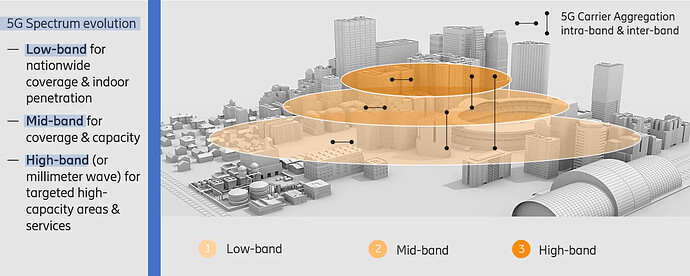-
My friend: Hi Ibrahim, I have a question for you.
- Me: Please, go ahead.
-
My friend: I was wondering what is the best 5G carrier to use if I am going to build a new 5G network?
- Me: Actually, to answer this question, we need to understand the different 5G bands and the advantage of each band to decide. So, as you know that 5G is using FR1 which is from 410 MHz till 7.125 GHz and FR2 which is from 24.25 till 52.6 GHz as per Rel.15 and even the 5G spectrum will be extended till 71 GHz in Rel.17. So, we have a very wide range of frequencies to use. For example, 5G carriers in low-band (less than 1GHz), will have a very good coverage which will be suited for large cells that will provide better mobility performance.
-
My friend: So, 5G carriers in low-band are the best to use, right?
- Me: Actually, 5G carriers in low-band has low bandwidth around 20 MHz, so they are offering lower capacity unlike 5G carriers in mid-band (between 1 and 7.125 GHz) which are providing higher capacity as they have higher bandwidth that can reach up to 100 MHz per carrier. But, the 5G carriers in mid-band has less footprint than 5G carriers in low-band. Currently, most of the MNOs around the world who are going to deploy 5G are using carriers in mid-band specifically the N78 band (around 3.5 GHz).
-
My friend: Now I got the answer, so 5G carriers in mid-band are the best to use as it is the favorite choice for most MNOs as you mentioned, right?
- Me: Not necessarily
 , as 5G carriers in high-band (mmWave range) are having the highest capacity among all 5G bands as they have the highest carrier bandwidth which can reach up to 400 MHz per carrier, but their coverage footprint is much lower than mid-band.
, as 5G carriers in high-band (mmWave range) are having the highest capacity among all 5G bands as they have the highest carrier bandwidth which can reach up to 400 MHz per carrier, but their coverage footprint is much lower than mid-band.
- Me: Not necessarily
-
My friend: So, which 5G carrier is the best to use? I am more confused now

- Me: Each 5G carrier has its own advantages, and the best way to bring all the advantages together is to build a 5G network where all carriers are deployed and by enabling carrier aggregation between all of them, you can bring a big advantage and amazing performance to your 5G network that can unlock a wider range of use case possibilities. I think that eventually, most 5G networks in the world will utilize low-, mid- and high-band spectrum to deliver the required network performance in different geographical areas, and to serve the evolving needs of consumers, society and businesses.
-
My friend: Thank you very much. You made it very clear.
- Me: You are most welcome.
LinkedIn: Ibrahim Sayed, PMP on LinkedIn: #5g #5gnr #5gtechnology
